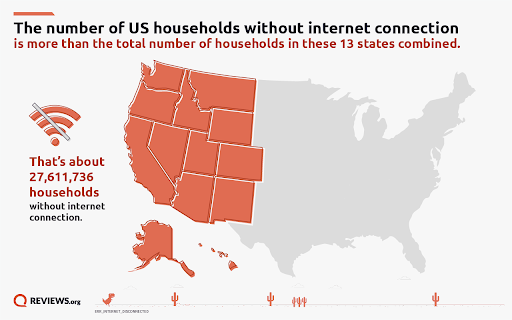October 8, 2021 9:20 AM

The Transform Technology Summits start October 13th with Low-Code/No Code: Enabling Enterprise Agility. Register now!
The COVID-19 pandemic caused a significant chunk of the U.S. workforce to rely upon their household internet, whether they liked it or not. As we know, collaboration was mostly video- and audio-conference-based. Predictably, connectivity and the presence of uninterrupted internet services played a crucial role in keeping services seamless.
Yet, when researchers at Reviews.org delved deeper to get a cogent picture of where connectivity standards in the country stood, the result was alarming.
While the numbers suggest a noticeably large market to explore, the data also show how a widening digital divide could hinder growth in some states and provoke workforces to move to better-connected areas. The implications of this could be vast. A look into the research numbers highlights a substantial digital divide among states.
Living without household internet
Not having household internet might sound like an obsolete proposition in this day and age, but that’s the case for 27.6 million U.S. households. In percentage terms, that’s a whopping 22.6%. If you round off the numbers, about 1 in 4 households do not have internet access.
What does that imply? This means lacking access to better employment opportunities, becoming more vulnerable to job threats that come with the shift to online, facing difficulties in accessing educational resources, and many more issues.
The study also found that more than 265,000 households in the country still use dial-up internet, a slow and outdated technology paradigm. Despite having connectivity at their locations, users stay deprived of the edge that comes with speed and faster access and exchange of information.

Not all states are equal in household internet usage
As applicable across households, the divide is wider among states. In Mississippi, a little more than 60% of households have the internet at their homes, the worst mark in the country. On the high end, Utah and California occupy rank first and second, with nearly 85% of households having internet service.
The implications of this household internet divide become all the more apparent when we look at the percentage of the rural population and the poverty rate of the most connected and the least connected states. Utah, Colorado, and California, with 84.8%, 84.7%, and 83.7% household internet coverage, have rural poverty rates of 11.2%, 12.70%, and 14.6%. The three least-connected states — Mississippi, Alabama, and Arkansas, with 60.1%, 64.5%, and 68.1% household internet coverage — have rural poverty rates ranging between 18.5% and 22.5%. In Mississippi, the rural population share is as high as 53.2%.
One does not need to be a data scientist to discover the link between rural areas having less coverage to generate fewer earning opportunities and reduced income. For small- and medium-scale enterprises that form the economic backbone of many of these states, compromised internet coverage results in poor digital infrastructure, slow communication, and lost opportunities.
VentureBeat
VentureBeat’s mission is to be a digital town square for technical decision-makers to gain knowledge about transformative technology and transact.
Our site delivers essential information on data technologies and strategies to guide you as you lead your organizations. We invite you to become a member of our community, to access:
- up-to-date information on the subjects of interest to you
- our newsletters
- gated thought-leader content and discounted access to our prized events, such as Transform 2021: Learn More
- networking features, and more
Leave a Reply Cancel reply
document.addEventListener(‘DOMContentLoaded’,function(){var commentForms=document.getElementsByClassName(‘jetpack_remote_comment’);for(var i=0;i<commentForms.length;i++){commentForms[i].allowTransparency=false;commentForms.scrolling='no';}}); <!–
